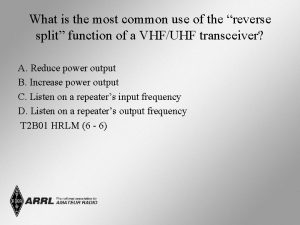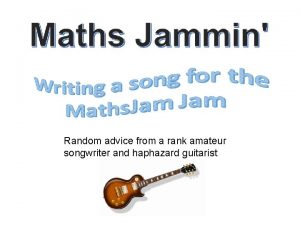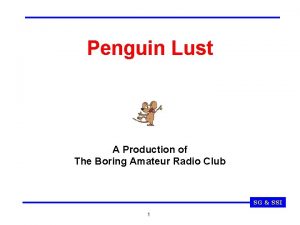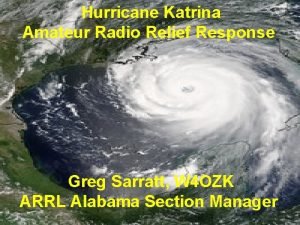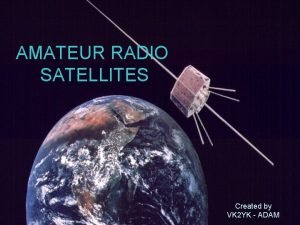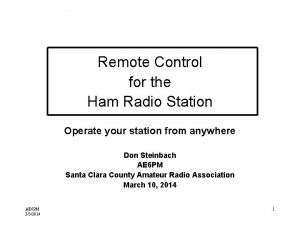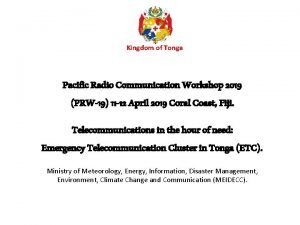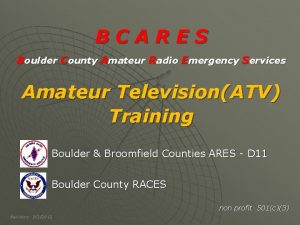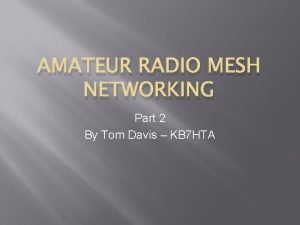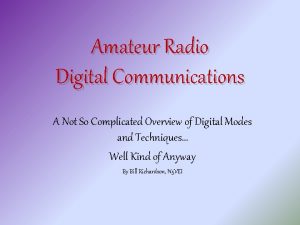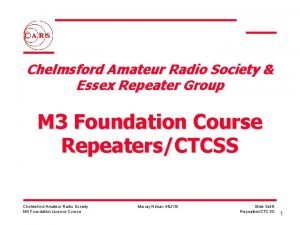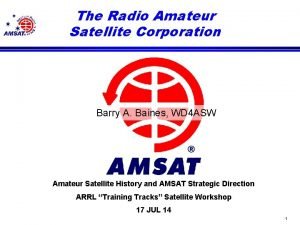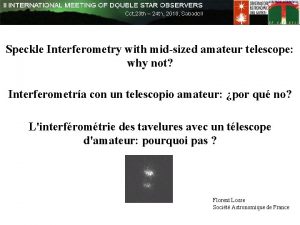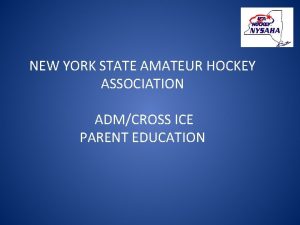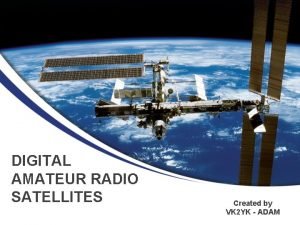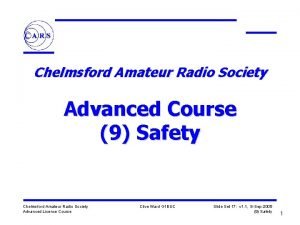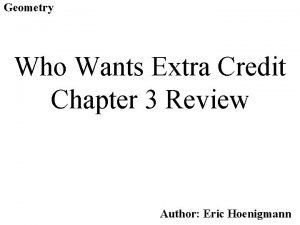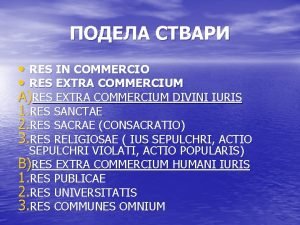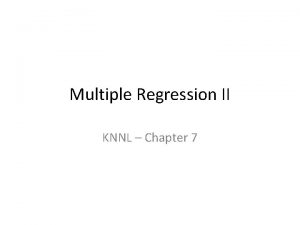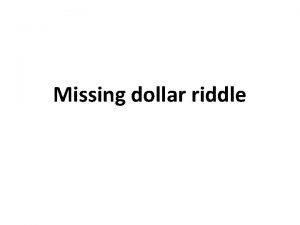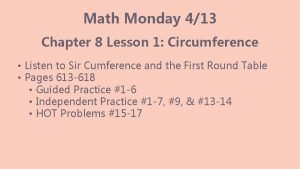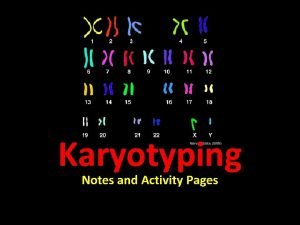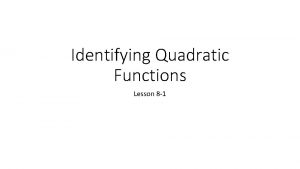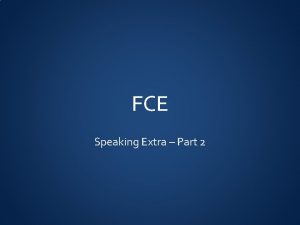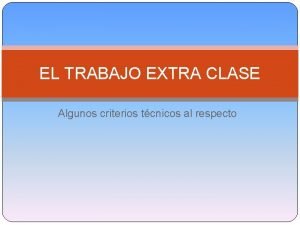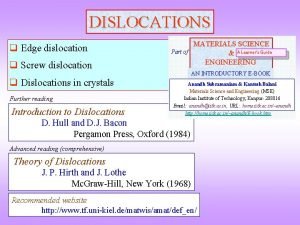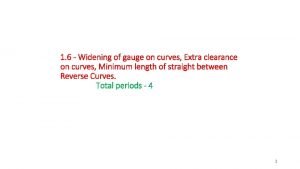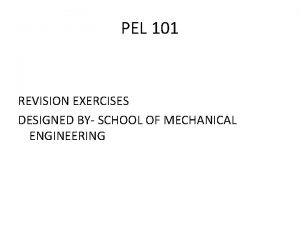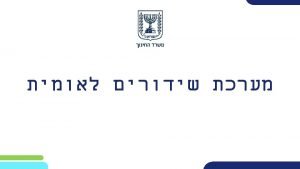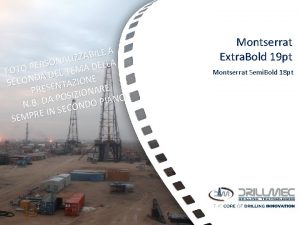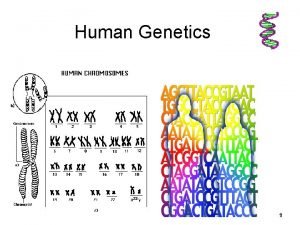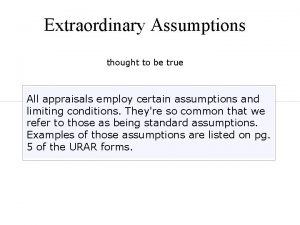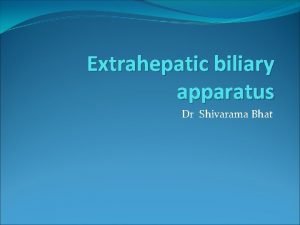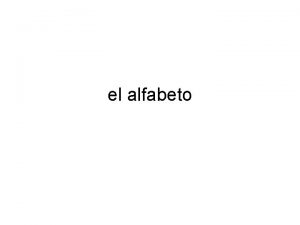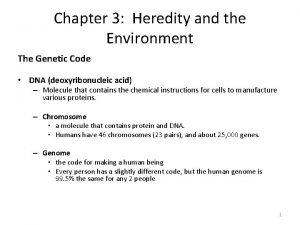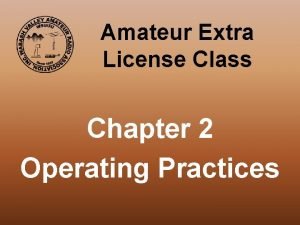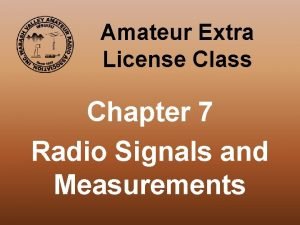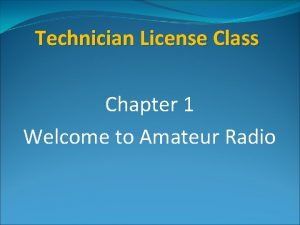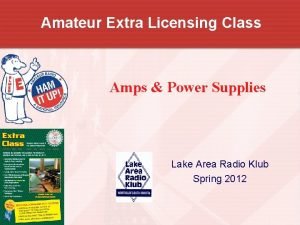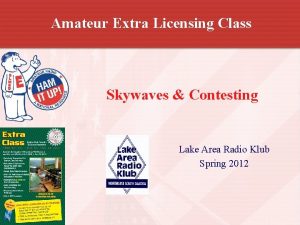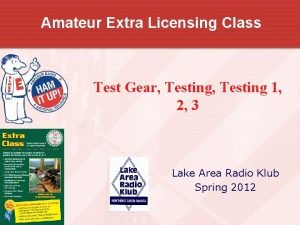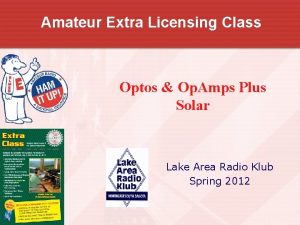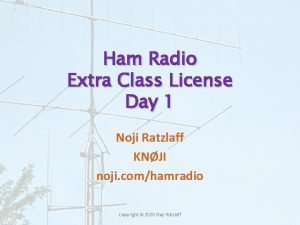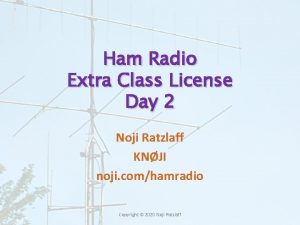Amateur Extra License Class Chapter 10 Topics in




























































































- Slides: 92

Amateur Extra License Class Chapter 10 Topics in Radio Propagation

Solar Effects • The sun has the biggest effect on HF propagation; even some effect on UHF and above • The Internet is a key source of information for tracking these effects • Spaceweather. com • Hfradio. org • Swpc. noaa. gov

Solar Effects • Solar flares • X-ray through Extreme UV (EUV) frequencies • Flare intensity: (lowest) A, B, C, M, X (highest) • Within “X Flares” (X 1, X 2, X 3, X 4) radio blackouts probable • An X 3 flare is twice as intense as an X 2

Solar Effects • Geomagnetic Field (GMF) • Its disruption negatively affects the ionosphere and thus refraction • Measurement parameters: • Bz : Interplanetary Magnetic Field (IMF): negative number implies alignment of IMF and Earth’s field = disruption (Geomagnetic Field Stability) • Southward orientation = greater likelihood of disturbance • K index: Measure of disruption: 0 (quiet), 9 major storm)

Solar Effects • Geomagnetic Field (GMF) • Its disruption negatively affects the ionosphere and thus refraction • Measurement parameters: • A index: Average of last 9 K index readings, 0 to 400 • G index: Derived from K and A indices: 0 (none), 1, 2, 3, 4, 5 (extreme)

Solar Effects • 304 A • NOAA reported value from 0 to unknown. Relative strength of total solar (UV) radiation at a wavelength of 304 angstroms (or 30. 4 nm), emitted primarily by ionized helium in the sun's photosphere. Responsible for about half of all the ionization of the F layer in the ionosphere. This is correlated to solar flux Index.

Solar Effects Most popular propagation Indices This is the banner on QRZ. com • Provided by N 0 NBH • Can be added to any web site

E 3 C 10 – What does the 304 A solar parameter measure? A. The ratio of X-Ray flux to radio flux, correlated to sun spot number B. UV emissions at 304 angstroms, correlated to solar flux index C. The solar wind velocity at 304 degrees for tme solar equator, correlated to solar activity D. The solar emission at 304 GHz, correlated to X -Ray flare levels

E 3 C 07 – Which of the following descriptors indicates the greatest solar flare intensity? A. Class A B. Class B C. Class M D. Class X

E 3 C 09 – How does the intensity of an X 3 flare compared to that of an X 2 flare? A. 10 percent greater B. 50 percent greater C. Twice as great D. Four times as great

E 3 C 04 – What does the value of Bz (B sub z) represent? A. Geomagnetic field stability B. Critical frequency for vertical transmissions C. Direction and strength of the interplanetary magnetic field D. Duration of long-delayed echos

E 3 C 05 – What orientation of Bz (B sub z) increases the likelihood that incoming particles from the Sun will cause disturbed conditions? A. Southward B. Northward C. Eastward D. Westward

E 3 C 02 -- What is indicated by a rising A or K index? A. Increasing disruption of the geomagnetic field B. Decreasing disruption of the geomagnetic field C. Higher levels of solar UV radiation D. An increase in the critical frequency

E 3 C 08 – What does the space weather term G 5 mean? A. An extreme geomagnetic storm B. Very low solar activity C. Moderate solar wind D. Waning sunspot numbers

HF Propagation • In nearly all cases, HF waves travel along the surface of the earth or they are returned to earth after encountering the upper layers of the ionosphere.

HF Propagation • All types of waves can change direction due to two different phenomena: • Diffraction. • Encountering a reflecting surface’s edge or corner. • Refraction. • Change in velocity due to change in properties of medium wave is traveling through.

HF Propagation • Ground Wave • Special type of diffraction. • Lower edge of wave (closest to the earth) loses energy due to induced ground currents. • Lower edge slows, tilting wave front forward. • Primarily effects vertically-polarized waves. • Most noticeable on longer wavelengths. • AM broadcast, 160 m, & 80 m. • Over distance, ground wave signal is absorbed, decreasing strength. • More pronounced at shorter wavelengths. • Most useful during daylight on 160 m & 80 m.

HF Propagation • Sky Wave • Radio waves refracted in the E & F layers of the ionosphere. • Maximum one-hop skip distance about 2500 miles.

HF Propagation • Sky Wave • Pedersen Ray. • High angle wave. • Provides propagation beyond normal maximum skip distance.

HF Propagation • Sky Wave • Chordal Hop • Successive ionospheric reflections without an intermediate reflection from the ground • Significantly less loss from ground absorption

HF Propagation • Sky Wave • Absorption. • D layer. • Ionized only during sunlight. • Absorbs RF energy. • The longer the wavelength, the more absorption. • Kills sky wave propagation on 160 m & 80 m during daylight hours.

HF Propagation • Extraordinary and Ordinary Waves • Linearly polarized waves are split into ordinary and extraordinary waves • Independent waves created in the ionosphere that are elliptically polarized.

HF Propagation • Long Path and Gray Line • Long path. • Radio waves travel a great-circle path between 2 stations. • The path is shorter in one direction & longer in the other. • The normal path is the shorter. • The long path is 180° from the short path.

HF Propagation • Long Path and Gray Line • Long path. • A slight echo on the received may indicate that longpath propagation is occurring. • With long path propagation, the received signal may be stronger if antenna is pointed 180° away from the station. • Long path propagation can occur on all MF & HF bands. • 160 m through 10 m. • Most often on 20 m.

HF Propagation • Long Path and Gray Line • Gray line propagation. • • At sunset, D layer collapses rapidly, reducing adsorption. F layer collapses more slowly. Similar effect occurs at sunrise. Net result is that long distance communications are possible during twilight hours on the lower frequency bands. • 8, 000 to 10, 000 miles. • 160 m, 80 m, 40 m, & possibly 30 m.

HF Propagation • Long Path and Gray Line • Gray line propagation.

HF Propagation • Fading • Variations in strength of received signals. • • Changes in height of ionized layers. Changes in amount of absorption. Random polarization shifts. Multi-path reflections.

HF Propagation • Fading • Selective fading. • Fading can have a different effect signals that are only a few hundred Hertz apart. • Can cause loss of mark or space signal of RTTY transmission. • Most severely affects wide-bandwidth signals such as AM or FM. • Can cause moderate to severe distortion of received signal.

HF Propagation • VOACAP • Voice of America Coverage Analysis Program • HF Propagation modeling software • Ray Tracing • Modeling a radio wave’s path through the ionosphere

HF Propagation • Solar Flares • Produce a sudden rise in radio background noise

HF Propagation • K index: Measure of disruption: 0 (quiet), 9 major storm) • A index: Average of last 9 K index readings, 0 to 400 • Rising A and K indices indicate increasing disruption of the geomagnetic field • Polar paths will experience high levels of absorption

E 3 C 12 -- How does the maximum distance of ground-wave propagation change when the signal frequency is increased? A. It stays the same B. It increases C. It decreases D. It peaks at roughly 14 MHz

E 3 C 13 -- What type of polarization is best for ground-wave propagation? A. Vertical B. Horizontal C. Circular D. Elliptical

E 3 B 12 – What is the primary characteristic of chordal hop propagation? A. Propagation away from the great circle bearing between stations B. Successive ionospheric reflections without an intermediate reflection from the ground C. Propagation across the geomagnetic equator D. Signals reflected back toward the transmitting station

E 3 B 13 – Why is chordal hop propagation desirable? A. The signal experiences less loss along the path compared to normal skip propagation B. The MUF for chordal hop propagation is much lower than for normal skip propagation C. Atmospheric noise is lower in the direction of chordal hop propagation D. Signals travel faster along ionospheric chords

E 3 B 04 – What is meant by the terms extraordinary and ordinary waves? A. Extraordinary waves describe rare long skip propagation compared to ordinary waves which travel shorter distances B. Independent waves created in the ionosphere that are elliptically polarized C. Long path and short path waves D. Refracted rays and reflected waves

E 3 B 14 – What happens to linearly polarized radio waves that split into ordinary and extraordinary waves in the ionosphere? A. They are bent toward the magnetic poles B. Their polarization is randomly modified C. They become elliptically polarized D. They become phase-locked

E 3 C 11 – What does VOACAP software model? A. AC voltage and impedance B. VHF radio propagation C. HF propagation D. AC current and impedance

E 3 C 01 – What does the term ray tracing describe in regard to radio communications? A. The process in which an electronic display presents a pattern B. Modeling a radio wave’s path through the ionosphere C. Determining the radiation pattern from an array of antennas D. Evaluating high voltage sources for X-Rays

E 3 C 03 – Which of the following signal paths is most likely to experience high levels of absorption when the A index and K index is elevated? A. Transequitorial propagation B. Polar paths C. Sporadic-E D. NVIS

E 3 C 15 – What might a sudden rise in radio background noise indicate? A. A meteor ping B. A solar flare has occurred C. Increased transequitorial propagation likely D. Long-path propagation is occurring

E 3 B 07 -- Which of the following could account for hearing an echo on the received signal of a distant station? A. High D layer absorption B. Meteor scatter C. Transmit frequency is higher than the MUF D. Receipt of a signal by more than one path

E 3 B 05 -- Which amateur bands typically support long-path propagation? A. 160 to 40 meters B. 30 to 10 meters C. 160 to 10 meters D. 6 meters to 2 meters

E 3 B 06 -- Which of the following amateur bands most frequently provides long-path propagation? A. 80 meters B. 20 meters C. 10 meters D. 6 meters

E 3 B 08 -- What type of HF propagation is probably occurring if radio signals travel along the terminator between daylight and darkness? A. Transequatorial B. Sporadic-E C. Long-path D. Gray-line

E 3 B 10 -- What is the cause of gray-line propagation? A. At midday, the Sun being directly overhead superheats the ionosphere causing increased refraction of radio waves B. At twilight, D-layer absorption is low while Elayer and F-layer propagation remains high C. In darkness, solar absorption drops greatly while atmospheric ionization remains steady D. At mid afternoon, the Sun heats the ionosphere decreasing radio wave refraction and the MUF

Break

VHF/UHF/Microwave Propagation • Auroral Propagation

VHF/UHF/Microwave Propagation • Auroral Propagation • Charged particles from the sun (solar wind) are concentrated over the magnetic poles by the earth’s magnetic field & ionize the E-layer. • VHF & UHF propagation up to about 1, 400 miles.

VHF/UHF/Microwave Propagation • Sporadic-E Propagation • Occurs around the solstices – especially the Summer Solstice • Can occur at any time of the day

VHF/UHF/Microwave Propagation • Auroral Propagation • Reflections change rapidly. • All signals sound fluttery. • SSB signals sound raspy. • CW signals sound like they are modulated with white noise. • CW most effective mode. • Point antenna toward aurora, NOT towards station. • In US, point antenna north.

VHF/UHF/Microwave Propagation • Meteor Scatter Communications • Meteors passing through the ionosphere collide with air molecules & strip off electrons. • Ionization occurs at or near the E-region. • Best propagation 28 MHz to 148 MHz. • 20 MHz to 432 MHz possible.

VHF/UHF/Microwave Propagation • Meteor Scatter Communications • Major meteor showers. • • • Quadrantids January 3 -5. Lyrids – April 19 -23. Arietids – June 8. Aquarids – July 26 -31. Perseids – July 27 to August 14. Orionids – October 18 -24. Taurids – October 26 to November 16. Leonids – November 14 -16. Geminids – December 10 -14. Ursids – December 22.

VHF/UHF/Microwave Propagation • Meteor Scatter Communications • Operating techniques. • Keep transmissions SHORT. • Divide each minute into four 15 -second segments. • Stations at west end of path transmit during 1 st & 3 rd segments. • Stations at east end of path transmit during 2 nd & 4 th segments.

VHF/UHF/Microwave Propagation • Meteor Scatter Communications • Operating techniques. • Modes: • High Speed CW. • 800 -2, 000 wpm. • Computer generated & decoded. • Digital - FSK 441 (part of WSJT software suite). • Repeated short bursts of data • Call Sign; Report

VHF/UHF/Microwave Propagation • Above 30 MHz, radio waves are rarely refracted back to earth by the ionosphere. • Must use other techniques for long-distance communications. • Low-angle of radiation from the antenna is more important than on HF. • It is more important for polarization of transmitting & receiving antennas to match than on HF.

VHF/UHF/Microwave Propagation • Radio Horizon • Radio horizon not the same as visual horizon. • Refraction in the atmosphere bends radio waves & increases “line-of-sight” distance by about 15%. Visual Horizon (miles) ≈ 1. 32 Hft Radio Horizon (miles) ≈ 1. 415 Hft

VHF/UHF/Microwave Propagation • Multipath • Radio waves reflected off of many objects arrive at receive antenna at different times. • Waves reinforce or cancel each other depending on phase relationship. • Picket fencing.

VHF/UHF/Microwave Propagation • Rain scattering • microwave propagation • best observed around 10 GHz, but extends down to a few gigahertz • This mode scatters signals mostly forwards and backwards when using horizontal polarization and side-scattering with vertical polarization. Forwardscattering typically yields propagation ranges of 800 km (approx. 500 miles). • Rain must be w/in the radio range of both stations

VHF/UHF/Microwave Propagation • Tropospheric Propagation • VHF/UHF propagation normally limited to 500 miles. • Certain atmospheric conditions can create a “duct” where radio waves can travel for hundreds or thousands of miles. • Bands: • 6 m – Rare. • 2 m – Fairly common. • 70 cm – Common.

VHF/UHF/Microwave Propagation • Tropospheric Propagation • Temperature Inversion • Along Warm and Cold Fronts

VHF/UHF/Microwave Propagation 0 1 2 NIL SIG MARGIN FAIR AL 3 4 6 7 8 9 10+ VERY STRON INTENS EXTREME G E U = UNSTABLE SIGNAL AREAS MODER GOOD ATE • Tropospheric Propagation 5 • Hepburn Map: www. dxinfocentre. com/tropo. html

VHF/UHF/Microwave Propagation • Transequatorial Propagation • Communications between stations located an equal distance north & south of the magnetic equator.

VHF/UHF/Microwave Propagation • Transequatorial Propagation • Most prevalent around the spring & autumn equinoxes. • Maximum effect during afternoon & early evening. • Allows contacts up to about 5, 000 miles. • Useable up to 2 m & somewhat on 70 cm. • As frequency increases, paths more restricted to exactly equidistant from and perpendicular to the magnetic equator.

VHF/UHF/Microwave Propagation • Earth-Moon-Earth (EME) Communications. • a. k. a. – Moon bounce. • If both stations can “see” the moon, they can talk. • Maximum about 12, 000 miles. • Best when moon is at perigee. • 2 d. B less path loss. • Not useable near new moon. • Increased noise from the sun. • The higher the moon is in the sky the better.

VHF/UHF/Microwave Propagation • Earth-Moon-Earth (EME) Communications. • Low receiver noise figure essential. • Libration Fading. • Caused by multipath effects of rough moon surface in combination with relative motion between the earth and the moon. • Rapid, deep, irregular fading. • 20 d. B or more. • Up to 10 Hz. • Can cause slow-speed CW to sound like high-speed CW.

VHF/UHF/Microwave Propagation • Earth-Moon-Earth (EME) Communications. • Time synchronous transmissions alternately from each station • 2 m operation. • 144. 000 MHz to 144. 100 MHz. • 2 -minute schedule. • Transmit for 2 minutes. • Receive for 2 minutes. • Station farthest east transmits first then station to the west.

VHF/UHF/Microwave Propagation • Earth-Moon-Earth (EME) Communications. • 70 cm operation. • 432. 000 MHz to 432. 100 MHz. • 2. 5 -minute schedule. • Transmit for 2. 5 minutes • Receive for 2. 5 minutes. • Station farthest east transmits first then station to the west.

E 3 C 14 -- Why does the radio-path horizon distance exceed the geometric horizon? A. E-region skip B. D-region skip C. Downward bending due to aurora refraction D. Downward bending due to density variations in the atmosphere

E 3 C 06 -- By how much does the VHF/UHF radiopath horizon distance exceed the geometric horizon? A. By approximately 15% of the distance B. By approximately twice the distance C. By approximately one-half the distance D. By approximately four times the distance

E 3 A 05 – Tropospheric propagation of microwave signals often occurs along what weather related structure? A. Gray-line B. Lightning discharges C. Warm and cold fronts D. Sprites and jets

E 3 A 10 -- Which type of atmospheric structure can create a path for microwave propagation? A. The jet stream B. Temperature inversion C. Wind shear D. Dust devil

E 3 A 07 – Atmospheric ducts capable of propagating microwave signals often form over what geographic feature? A. Mountain ranges B. Forests C. Bodies of water D. Urban areas

E 3 A 11 – What is a typical range for tropospheric propagation of microwave signals? A. 10 miles to 50 miles B. 100 miles to 300 miles C. 1200 miles D. 2500 miles

E 3 A 04 – What do Hepburn map predict? A. Sporadic E propagation B. Locations of auroral reflecting zones C. Likelihood of rain scatter along cold or warm fronts D. Probability of tropospheric propagation

E 3 A 06 – Which of the following is required for microwave propagation via rain scatter? A. Rain droplets must be electrically charged B. Rain droplets must be within the E layer C. The rain must be within radio range of both stations D. All of these choices are correct

E 3 B 09 -- At what time of the year is Sporadic E propagation most likely to occur? A. Around the solstices, especially the summer solstice B. Around the solstices, especially the winter solstice C. Around the equinoxes, especially the spring equinox D. Around the equinoxes, especially the fall equinox

E 3 B 11 – At what time of day is Sporadic-E propagation most likely to occur? A. Around sunset B. Around sunrise C. Early evening D. Any time

E 3 B 01 -- What is transequatorial propagation? A. Propagation between two mid-latitude points at approximately the same distance north and south of the magnetic equator B. Propagation between any two points located on the magnetic equator C. Propagation between two continents by way of ducts along the magnetic equator D. Propagation between two stations at the same latitude

E 3 B 03 -- What is the best time of day for transequatorial propagation? A. Morning B. Noon C. Afternoon or early evening D. Late at night

E 3 B 02 -- What is the approximate maximum range for signals using transequatorial propagation? A. 1000 miles B. 2500 miles C. 5000 miles D. 7500 miles

E 3 A 12 – What is the cause of auroral activity? A. The interaction is the F 2 layer between the solar wind and the Van Allen belt B. A low sunspot level combined with tropospheric ducting C. The interaction in the E layer of charged particles for the Sun with the Earth’s magnetic filed D. Meteor showers concentrated in the extreme northern and southern latitudes

E 3 A 13 – Which emission mode is best for auroral propagation? A. CW B. SSB C. FM D. RTTY

E 3 A 14 – From the contiguous 48 states, in which approximate direction should an antenna be pointed to take maximum advantage of aurora propagation? A. South B. North C. East D. West

E 3 A 09 -- Which of the following frequency range is well suited for meteor scatter communications? A. 1. 8 - 1. 9 MHz B. 10 - 14 MHz C. 28 - 148 MHz D. 220 - 450 MHz

E 3 A 08 -- When a meteor strikes the Earth's atmosphere, a cylindrical region of free electrons is formed at what layer of the ionosphere? A. The E layer B. The F 1 layer C. The F 2 layer D. The D layer

E 2 D 02 – Which of the following is a good technique for making meteor scatter contacts? A. 15 second times transmission sequences with station alternating base on location B. Use of high speed CW or digital modes C. Short transmission with rapidly repeated call sign and signal reports D. All of these choices are correct

E 3 A 01 -- What is the approximate maximum separation measured along the surface of the Earth between two stations communicating by Moon bounce? A. 500 miles, if the Moon is at perigee B. 2000 miles, if the Moon is at apogee C. 5000 miles, if the Moon is at perigee D. 12, 000 miles if the Moon is visible by both stations

E 3 A 03 -- When scheduling EME contacts, which of these conditions will generally result in the least path loss? A. When the Moon is at perigee B. When the Moon is full C. When the Moon is at apogee D. When the MUF is above 30 MHz

E 3 A 02 -- What characterizes libration fading of an EME signal? A. A slow change in the pitch of the CW signal B. A fluttery irregular fading C. A gradual loss of signal as the Sun rises D. The returning echo is several hertz lower in frequency than the transmitted signal

E 2 D 06 -- Which of the following describes a method of establishing EME contacts? A. Time synchronous transmissions alternately from each station B. Storing and forwarding digital messages C. Judging optimum transmission times by monitoring beacons reflected from the Moon. D. High speed CW identification to avoid fading

Questions?
 Where may ssb phone be used in amateur bands above 50 mhz?
Where may ssb phone be used in amateur bands above 50 mhz? Random amateur
Random amateur Club lust production
Club lust production Katrina amateur
Katrina amateur Vk amateur
Vk amateur Emma holton nude
Emma holton nude Ham radio remote
Ham radio remote Tonga amateur radio
Tonga amateur radio Bcares
Bcares Linkcalc ubnt
Linkcalc ubnt Amateur radio digital communications
Amateur radio digital communications Chelmsford amateur radio society
Chelmsford amateur radio society Amateur sp
Amateur sp Amateur sdx
Amateur sdx Japanese amateur hot
Japanese amateur hot Student teacher amateur
Student teacher amateur Insemination amateur
Insemination amateur Telescopio amateur
Telescopio amateur New york state amateur hockey association
New york state amateur hockey association Vk amateur
Vk amateur Chelmsford amateur radio society
Chelmsford amateur radio society Chelmsford amateur radio society
Chelmsford amateur radio society Amateur radio mesh network
Amateur radio mesh network Driver license class
Driver license class Class c license
Class c license Notice questions for class 7
Notice questions for class 7 Power point presentation topic in hindi
Power point presentation topic in hindi In geometry
In geometry Extra credit chapter 15
Extra credit chapter 15 Nj driving manual
Nj driving manual Chapter 1 nj driver license system
Chapter 1 nj driver license system Chapter 1 the new jersey driver license system answers
Chapter 1 the new jersey driver license system answers Chapter 9 topics in analytic geometry
Chapter 9 topics in analytic geometry Radazin herbicid
Radazin herbicid Relative clauses with extra information
Relative clauses with extra information Res extra commercium
Res extra commercium Extra rich massage balsam siberian blend
Extra rich massage balsam siberian blend Res commercio
Res commercio Classification of retainers
Classification of retainers Nnn extra broadcast
Nnn extra broadcast Extra information clauses
Extra information clauses Billing tamu
Billing tamu Res in patrimonio
Res in patrimonio Extra sum of squares multiple regression
Extra sum of squares multiple regression Three guys at a hotel riddle
Three guys at a hotel riddle Www.atantot-extra.co.uk
Www.atantot-extra.co.uk Lesson 1 problem solving practice circumference
Lesson 1 problem solving practice circumference Luxation extra coracoidienne
Luxation extra coracoidienne Edwards syndrome
Edwards syndrome Operazioni triangolari extra ue
Operazioni triangolari extra ue Avolition definition schizophrenia
Avolition definition schizophrenia Lesson 8-1 identifying quadratic functions
Lesson 8-1 identifying quadratic functions Xyy chromosome
Xyy chromosome Extra y chromosome
Extra y chromosome Fce speaking part 2 pictures
Fce speaking part 2 pictures Extra lesson antroposofia
Extra lesson antroposofia Trabajo extra clase
Trabajo extra clase Edge and screw dislocation
Edge and screw dislocation Inter intra extra
Inter intra extra Extaramove
Extaramove Widening of gauge on curves
Widening of gauge on curves Res extra commercium
Res extra commercium Ira pré renal renal e pós renal
Ira pré renal renal e pós renal Suprabulge retainers
Suprabulge retainers At wendy's washateria all of the dryer
At wendy's washateria all of the dryer Fonte open sans
Fonte open sans Extra pair copulations
Extra pair copulations The extra dopamine released during drug use can
The extra dopamine released during drug use can Medicover pakiet zdrowie premium zakres
Medicover pakiet zdrowie premium zakres Extra markup html
Extra markup html Humana ante oculos foede cum vita iaceret
Humana ante oculos foede cum vita iaceret Count the day lost
Count the day lost Coleção extra-axial benigna da infância
Coleção extra-axial benigna da infância Montserrat extra
Montserrat extra Extra x chromosome
Extra x chromosome Senin aşkın bana extra large
Senin aşkın bana extra large Extra credit anime
Extra credit anime Klinefelter's syndrome
Klinefelter's syndrome Extraordinary assumptions and hypothetical conditions
Extraordinary assumptions and hypothetical conditions Biliary apparatus
Biliary apparatus El alfabeto pronunciation
El alfabeto pronunciation Extra topicality
Extra topicality Hora extra
Hora extra Extra x
Extra x Extra x
Extra x Choroid plexus papilloma
Choroid plexus papilloma Rheumatoid arthritis extra-articular manifestations
Rheumatoid arthritis extra-articular manifestations K5 think central
K5 think central Us extra fancy
Us extra fancy Lower rpd design
Lower rpd design Pneumoperitoine scanner
Pneumoperitoine scanner Uova extra fresche normativa
Uova extra fresche normativa Extra credit avance
Extra credit avance
